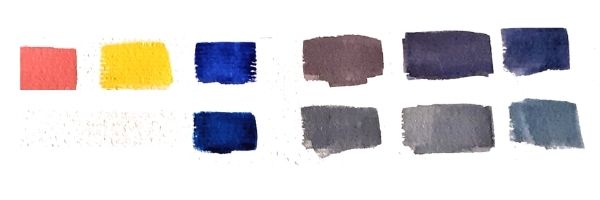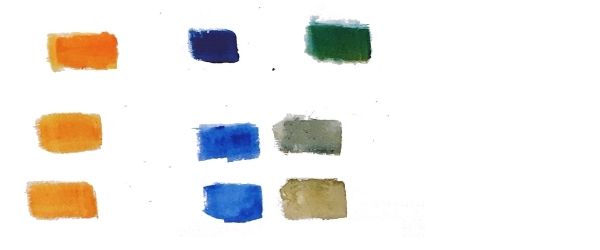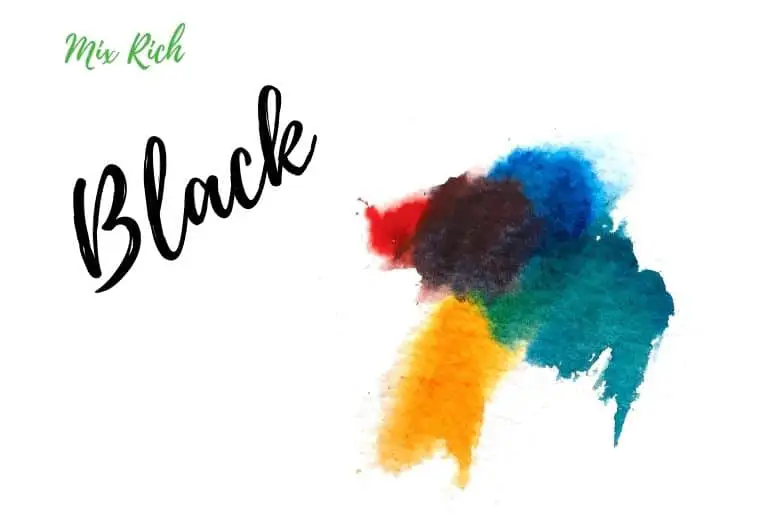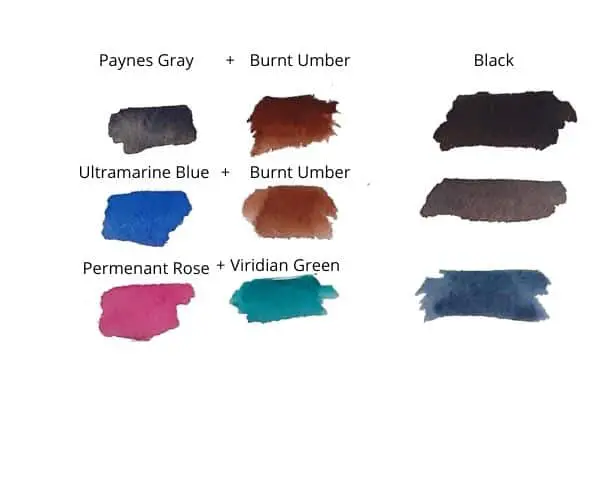I wanted to use black in my watercolors but found the tube and pan blacks often too heavy or bland. By learning to mix my own black I found that my painting became richer and more vibrant, the black didn’t overpower the picture. While black is essentially mixed with the three primaries there is a lot more to mixing black as a watercolor artist to make the best of its use in your artwork.
To mix black using watercolor paints you can use your three primary colors, red, yellow, and blue. Or mix two color combinations of purple and yellow, green and red, or orange and blue to make black. Earth colors can also be muted as an alternative black.
The advantages of knowing how to mix black as an artist rather than just mixing plain black are many. Black from tubes can be dull and suck the life out of your work. By mixing your own black you can choose which colors to use that suit your picture. You can pick your own color bias in your blacks to have warmer, cooler, or neutral black. Mixing black with watercolor isn’t difficult however there are sometimes surprises when things don’t work. Below I have gone into how to mix black with different colors, 2 and 3 color mixes, what to do when it goes wrong and you don’t get the color you want and why this is.
How to Mix & Correct Black In Watercolor Using 2 or 3 Colors
What Colors Make Black?
There are lots of different color combinations that make black but whatever combination of colors you choose, you need the three primaries blue, red, and yellow to be included in your mix. This is the same regardless of whether you are using watercolor or other types of paint like oil or acrylic.
The challenge for us artists is that the blue, yellow, and red advice is too simplistic. Our colors are rarely pure and we often need or even want that bias in our work. This complicates things a bit. . We either want our mix warm or cool or slightly purple or brown, etc. When we mix our colors they don’t always work as expected due to this bias.
Example: using blue red and yellow watercolors to make black
The aim here is not to say use a certain color to make black, but to give you a range of options and methods for you to be able to use the colors from your own palette. By understanding what makes black, why it does and when it does not, and how to correct that you can then take your own colors and create your own unique rich range of blacks. Everyone uses different brands and different countries have different names for colors so it’s no good just saying use a certain color if you do not have it available.
Don’t worry if you don’t have these exact colors just use the ones you have.
Use A Selection of Your 6 Core Colors to Make Black – Blue, Red & Yellow Make Black
Most artists will have one warm and one cool of each of the primary colors. As black absorbs all colors using the 3 primaries works well for mixing black. This gives a very strong “pure” black. Many of the other options give variations of black. Lighter blues I find don’t work as well.
The difficulty is getting the right amounts of each color. You can see from the two examples below that the mixed color varies.
Use A 3 Colour Mix to Make Black

- Row 1 above, Scarlet Lake (Cadmium Red Hue), ultramarine blue, and Lemon Yellow.
- Row 2 I have swapped ultramarine blue for Intense Blue (Phthalo Blue or Winsor Blue (Green Shade))

The two examples above make different blacks just by swapping out the blue or the yellow.
Tip: Try to use the colors to make black you are already using in your picture to create more harmony and avoid too many colors.
Three Color Mixing & Color Correcting To Make Black In Watercolor
Below are two sets of black mixes the only change I have made is to change the blue.
- I have used lemon yellow, scarlet red (cad red), and ultramarine blue in Group 1.
- In group two I have used the same red and yellow and changed the blue to intense blue (phthalo blue)
This shows just how different your mixes can be even with slight changes to the colors or the quantity of a specific color.
It also shows that even with different colors if you follow some simple guidelines you can easily mix rich blacks that match your pictures with most reds, yellows, and blues you have in your palette.
Tip: I find the easiest way to make black with 3 colors is to mix two of the 3 colors together to make either orange, green, or purple then add its complementary color in small amounts rather than trying to mix all three colors together.
- (red and yellow) orange + blue
- (blue and yellow) green + red
- (red and blue) purple + yellow
With watercolor, you have the added color of white in the paper itself. If you want a strong black keep your paint as undiluted as possible or your paint will end up either being gray or weak purple or brown, etc.
Group 1 Example, Black Mix Using Lemon Yellow, Ultramarine Blue, and Scarlet Red

Row 1 Mix together an even mix of the lemon yellow and scarlet lake (cadmium red) to make orange. To that add the same amount of the complement to orange in this case ultramarine blue. You can see here that doesn’t quite make black so add smaller amounts of blue until it darkens down. This color is near to black but with a slight blown bias. If you want a warmer black simply switch out the lemon yellow for Hansa/cadmium yellow.
Row 2 Add an even mix of yellow and blue to make green then add slightly more blue then the complementary color to green which is red to make a clean black.
Row 3 Mix the yellow and the red together this time use more yellow than red to make orange as a touch of blue you get brown, increase the blue and you get a really lovely neutral black.
When you consider that all three of these mixes are with the same colors it’s surprising how mixing them slightly differently can make a huge difference to the outcome. This also applies if you use different colors because of their color bias.
Below I have done the same with Group 2 the only change is the blue.
Group 2 Example – Mix Black Watercolors With Lemon Yellow, Scarlet Red, and Intense Blue

Row 1 Is an even as possible mix of all 3 colors (lemon yellow, Scarlet Lake (Cad Red), and intense blue. This produces a nice dark clean even black.
Row 2 is a mix of 2 x lemon yellow to Intense blue to create a dark green then add a touch of its complementary color red (cad red/scarlet lake). This gives a good black. If you add too much red it starts to tip to brown as you can see in the 3rd color. It’s better to add small amounts of red and increase it to get your color.
Row 3– a) I have added more yellow than red to create the orange (lemon yellow + scarlet lake/cad red). b) Then added the compliment, blue but a lot less blue than before (Row 1) to the orange. This creates a blue-green. To correct this increase the red. This then turns the 2nd color black. Increase this in small amounts or you will end up with too much red.
Tip: Allow for the color to be lighter when dry and also I have mixed intense colors here as it is often difficult to get the image to transfer cleanly when photographing it. If you mix watercolor you will likely start with a much lighter thinner mix than shown here.
How to Mix Black Watercolors With Only 2 Colors
With the two-color mixes, some of the work has been done for you. But this can cause issues as the colors are not always what they seem. To create black with only 2 colors take whatever color you are using and add its complement to the color wheel.
- orange + blue
- green + red
- purple + yellow
Green and Red

- Viridian Green and Alizarin Crimson
Oranges and Blue Make Black

Cadmium Orange and ultramarine blue mixed together make a good black. If you have other oranges you may find that you don’t always get black. If so the next section on correcting your blacks may help.
Mix Purple and Yellow To Make Black

This looks better on screen than off. This is a mix of mauve and Hansa yellow. This color is almost black but not quite. If you are having issues getting black the next part of my article will help.
Why Doesn’t Orange & Blue and Purple and Yellow (Always) Make Black?
According to color theory and a lot of artists. Orange and blue and purple and yellow also make black. They should, they have all three colors in them. But they don’t always. It is possible to have the same issue with the other colors and it will depend on what is on your palette as to the results but these often don’t act as they are supposed to, at least for me.
Why Your 2 Color Mixes Don’t Always Make Black And What To Do About It
Sometimes you follow the above guide and you just don’t get the right color. For me, it’s usually orange. Why orange I don’ know. Maybe it’s just my choice of oranges! But this system does not work with orange for me. I have an orange in acrylics that I’d swear has absolutely no yellow in it lol. Of course, it must have it or it would be red! So why doesn’t it work?
This is a question I asked myself and if you are reading this then it’s likely you are having similar issues.
So what’s going wrong and how to fix it? This applies to any of your 2 color mixes. I’m just using orange as an example.
Here I mixed orange with blue and got green! Did doesn’t matter what proportions I mixed the paint in I still got green. This used to bug me because you have your three primaries here yellow red and blue. It should work. But it doesn’t.

A Quick Solution To Color Correct to Make Your Black
The quickest and easiest way to correct your black is to look at the final color you mix as that will tell you the color you are missing. In this case, I end up with green no matter how much of either color I have so there’s a definite lack of red.
To correct this make sure you have a darker green like above and then simply add red to your green. Start off with smaller amounts and continue adding until your mix goes black. If you get brown you have gone too far with the red or don’t have enough blue. This is the same as mixing with three colors only you have missed out on the first stage.
There will nearly always be a slight bias when mixing blacks rather than using from the tube. This is an advantage when mixing your own blacks once you get the hang of it.
More Detailed Explanation For Failure to Mix Black Watercolors
The trouble is not only are you dealing with color bias but the amount of color in that color mix in this case orange.
This is Daler Rowney orange + Intense Blue
What you are actually mixing is Arylamide Yellow PY1 & Naphthol Red PR9 plus intense blue.
Note: My paint colors are named slightly different as the bands vary slightly but as you can see from the orange they are close colors.
Here I get green no matter what blue I use :

The color bias of one of the colors is affecting the mix and tipping the balance towards green. This can be because:
- The orange doesn’t have enough red in it.
- The blue doesn’t have red in them.
- Or the blues have too much yellow in them.
To correct this I simply add the complementary color – red.
Below I reduce the amount of orange in the mix slightly and add a red. Try to add a red that doesn’t increase the yellow or blue too much. You can see what happens here when I increase the amount of red.

Above are mixes of Rowney orange with intense blue (row 1), ultramarine blue (Row 2), and cobalt blue (hue) (Row 3). All make green. Then I add scarlet lake (cadmium red) in small amounts until the mixture goes black. Interestingly my cobalt hue has white in it but clearly not enough to make the mix go gray.
Other Colors That You Can Use to Make Black
Below are some of the other colors you can use to make black.
Purple and Green

Here I use mauve and leaf green to make black. (Leaf green is made up of Arylamide Yellow(Hansa yellow and Phthalocyanine Green (Phthalo)).
The Advantages of Mixing Your Own Black
- The advantage of mixing your blacks this way is you end up with a vibrant black. Each one is slightly different.
- When you use watercolors you can also pick your color mixes that are more or less transparent or more opaque depending on what you are painting.
- You can also pick ones that are grainy or not. So you might want to vary how you make your black depending on your needs.
- If you have a palette with spaces you do not need to take up that space with black if you don’t want to.
By mixing your own blacks you can use the black for the darkest of areas for shadows then adapt the same mix for the lighter areas of shadows. this uses a more limited palette and helps to create harmony in the picture.





